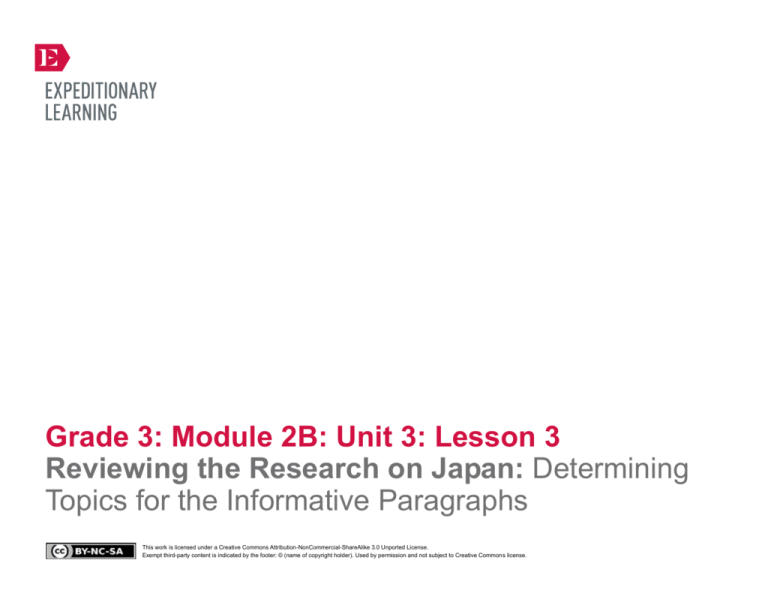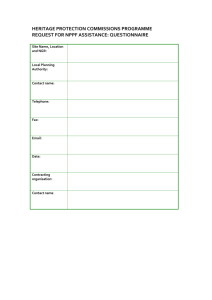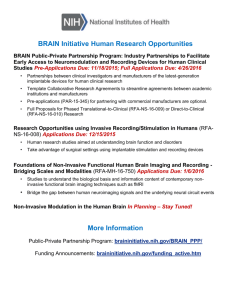
Grade 3: Module 2B: Unit 3: Lesson 3
Reviewing the Research on Japan: Determining
Topics for the Informative Paragraphs
This work is licensed under a Creative Commons Attribution-NonCommercial-ShareAlike 3.0 Unported License.
Exempt third-party content is indicated by the footer: © (name of copyright holder). Used by permission and not subject to Creative Commons license.
GRADE 3: MODULE 2B: UNIT 3: LESSON 3
Reviewing the Research on Japan:
Determining Topics for the Informative Paragraphs
Long-Term Targets Addressed (Based on NYSP12 ELA CCLS)
I can produce writing that is appropriate to task and purpose (with support). (W.3.4)
I can use the writing process to plan, revise, and edit my writing (with support). (W.3.5)
I can sort evidence into provided categories. (W.3.8)
I can use conventions to send a clear message to my reader. (L.3.2)
I can compare how people use language when they write versus when they talk. (L.3.3b)
Supporting Learning Targets
Ongoing Assessment
• I can capitalize appropriate words, such as names and titles.
• Letters to a family member or friend
• I can review information gathered from my research on Japan.
• Topic Decision recording form
• I can use the Topic Decision recording form to identify the topics of my two informative paragraphs for
my Japan practice letter.
Copyright © 2013 by Expeditionary Learning, New York, NY. All Rights Reserved.
NYS Common Core ELA Curriculum • G3:M2B:U3:L3 • June 2014 • 1
GRADE 3: MODULE 2B: UNIT 3: LESSON 3
Reviewing the Research on Japan:
Determining Topics for the Informative Paragraphs
Agenda
Teaching Notes
1. Opening
• Students continue their guided writing experience about Japan, begun in Lesson 2. In this lesson,
specifically, students learn how to determine topics for body paragraphs so that they can apply this
learning in on-demand writing about their expert country during the Mid-Unit 3 Assessment (in Lesson
7).
A. Warming Up with Conventions (13 minutes)
B. Unpacking the Learning Targets (2 minutes)
2. Work Time
A. Reviewing the Japan Recording Forms (8 minutes)
B. Determining Topics for the Body Paragraphs: Using
the Topic Decision Recording Form (35 minutes)
3. Closing and Assessment
A. Revisit the Learning Targets (2 minutes)
4. Homework
A. Complete the Using Capitalization Correctly
Homework form.
• This lesson includes a think aloud in which you show students how to choose a topic to write about. A
sample think aloud has been provided for writing about kanji (from Japan). While conducting this
think-aloud, fill in the recording form (as students would) so students can see the authentic task in
progress.
• This lesson begins with a warm-up about correct capitalization in writing. Students use the letter they
have crafted for homework to check for accuracy with capitalizing names and titles. A Summary of
Conventions for Third Grade has been included in the supporting materials for teacher reference.
Consider collecting students’ letters as a formative assessment.
• Also see the module overview and the stand-alone document titled Foundational Reading and Language
Standards Resources Package for Grades 3–5. This resource package is designed to give teachers
resources and guidance for addressing the CCSS foundational reading and language ELA standards,
including the Show the Rule™ strategy for teaching language conventions. This would be a natural
extension of the mini-lesson in Opening A.
• In Lesson 4, students will engage in partner work to draft the body paragraphs for their Japan practice
letter. In order to do that, they first need to make a decision about what topics they will write about in
their two body paragraphs. Students also need a structure for reviewing the many recording forms they
have completed on Japan. It is from these recording forms that they will choose their topics. In this
lesson, the Topic Decision recording form is introduced to provide a structure for the review of
information on the Japan recording forms.
• Consider placing each student’s collection of recording forms in a folder created by folding a 12-by-18
piece of construction paper in half.
Copyright © 2013 by Expeditionary Learning, New York, NY. All Rights Reserved.
NYS Common Core ELA Curriculum • G3:M2B:U3:L3 • June 2014 • 2
GRADE 3: MODULE 2B: UNIT 3: LESSON 3
Reviewing the Research on Japan:
Determining Topics for the Informative Paragraphs
Agenda
Teaching Notes (continued)
• In advance:
– Create and post the Words We Capitalize in Writing anchor chart.
– Gather students’ Exploring Culture (Customs) recording forms and Exploring Culture (Traditions)
recording forms from Unit 1, Lessons 10 and 11.
– Review the Exploring Culture (Customs) recording form (answers, for teacher reference) and
Exploring Culture (Traditions) recording form (answers, for teacher reference).
– Plan your think-aloud for Work Time B.
• Post: Learning targets.
Lesson Vocabulary
Materials
research-based, topic, body paragraph,
decision, capitalization
• Words We Capitalize in Writing anchor chart (new; teacher-created; see supporting materials)
• Analyzing the Model Letter anchor chart 2: Informative Body Paragraphs (begun in Lesson 1)
• Exploring Culture (Customs) recording form (from Unit 1, Lesson 10; one per student)
• Exploring Culture (Customs) recording form (answers from Unit 1, Lesson 10; for teacher reference)
• Exploring Culture (Traditions) recording form (from Unit 1, Lesson 11; one per student)
• Exploring Culture (Traditions) recording form (answers from Unit 1, Lesson 11; for teacher reference)
• Performance Task Model: Writing about France (from Lesson 1; one to display)
• Document camera
• Topic Decision recording form (one per student and one to display)
• Exploring Countries: Japan (book; distributed in Unit 2; one per student)
• Summary of Conventions for Third Grade (for teacher reference)
• Using Capitalization Correctly Homework form (one per student)
Copyright © 2013 by Expeditionary Learning, New York, NY. All Rights Reserved.
NYS Common Core ELA Curriculum • G3:M2B:U3:L3 • June 2014 • 3
GRADE 3: MODULE 2B: UNIT 3: LESSON 3
Reviewing the Research on Japan:
Determining Topics for the Informative Paragraphs
Opening
Meeting Students’ Needs
A. Warming Up with Conventions (13 minutes)
• Instruct students to have their letters to a family member or friend in hand. This homework was assigned in Lesson 1.
• If a student does not have his/her
homework letter, pair the student
with a peer who has completed the
work. Ensure that the student
completes the work at another point
in the day.
• Direct students’ attention to the learning targets and read the first one aloud:
* “I can capitalize appropriate words, such as names and titles.”
• Tell students that today they are going to do some writing. To warm up for writing, they will practice some editing. Ask:
* “Think back to Module 1. What do you remember about editing writing?”
• Ask for volunteers to share out.
• Inform students that they are going to look at the letter they wrote for homework and make sure they have capital letters in
the correct places.
• Display the Words We Capitalize in Writing anchor chart. Review the chart with students, discussing the various
rules for correct capitalization.
• Then, say something like: “There are several rules we need to remember as writers for when to capitalize words. Let’s
practice some together. I will give you a sample that has a capitalization mistake in it. If you see the mistake, put a silent
thumb at your heart.”
• Provide a couple of example sentences with incorrect capitalization for the class to correct together. Try to provide examples
that target each of the capitalization rules.
• Ask students to turn and talk:
* “What mistakes do you see, and how would you correct them?”
• Call on volunteers to share how to correct the mistakes.
• Invite students to read their letters aloud to themselves and look for incorrect capitalization.
• Allow time for students to correct their mistakes. If time permits, have them share their self-corrections with a peer.
Copyright © 2013 by Expeditionary Learning, New York, NY. All Rights Reserved.
NYS Common Core ELA Curriculum • G3:M2B:U3:L3 • June 2014 • 4
GRADE 3: MODULE 2B: UNIT 3: LESSON 3
Reviewing the Research on Japan:
Determining Topics for the Informative Paragraphs
Opening (continued)
Meeting Students’ Needs
B. Unpacking the Learning Targets (2 minutes)
• Ask students to move to sit with their writing partners.
• When unpacking the learning
targets, consider using visuals to
support the meaning of key words in
the target.
• Direct students’ attention to the remaining learning targets. Read one target aloud at a time, pausing after each to let
partners discuss what they think each target means.
• Cold call students to share out. Clarify as necessary.
Meeting Students’ Needs
Work Time
A. Reviewing the Japan Recording Forms (8 minutes)
• Display the Analyzing the Model Letter anchor chart 2 from Lesson 1.
• Remind students that they are working on writing letters to Mary Pope Osborne. In the previous lesson, they wrote the
opening to their letter with their writing partner. In this lesson, they will turn their focus to the two body paragraphs that
contain research and reasons as to why Mary Pope Osborne should write another story about Japan.
• Encourage students to think back on all the work they did learning about Japan in Unit 1. Ask:
* “Where might you look for information about Japan’s culture in the present day?”
Ask for volunteers to share out. Listen for them to say they need to look back at their Japan recording forms from their
Exploring Countries: Japan text.
• Ask students to locate their Exploring Culture (Customs) and Exploring Culture (Traditions) recording forms
about Japan.
• Tell them they will now review these recording forms with their writing partner.
• Allow partners about 8 minutes to review the two recording forms.
Copyright © 2013 by Expeditionary Learning, New York, NY. All Rights Reserved.
NYS Common Core ELA Curriculum • G3:M2B:U3:L3 • June 2014 • 5
GRADE 3: MODULE 2B: UNIT 3: LESSON 3
Reviewing the Research on Japan:
Determining Topics for the Informative Paragraphs
Meeting Students’ Needs
Work Time (continued)
B. Determining Topics for the Body Paragraphs: Using the Topic Decision Recording Form (35 minutes)
• Refocus students whole group. Display the Performance Task Model: Writing about France via a document
camera.
• Point to the two informative paragraphs as you say to students: “You all need a way to decide what to write about in the two
informative body paragraphs for your letter. You worked so hard in Unit 1 reading, researching, and recording information
about Japan’s culture. As you worked, you recorded information on the Exploring Culture (Customs) recording form and
Exploring Culture (Traditions) recording form. You just spent time refamiliarizing yourself with these recording forms. Now,
you will need to select two topics that relate to Japanese culture, one for each body paragraph in your letter.”
• Distribute the Topic Decision recording form and make sure students have their Exploring Countries: Japan text.
Display a copy of the recording form on the document camera.
• Review the steps listed at the top of the recording form:
– Look over the selected recording forms from Unit 1.
– Look for topics you think would be interesting for Mary Pope Osborne to use in her new story.
– Go back into the text and reread. This will help you make your decision.
– If you feel that a topic might work, list it in the left-side column.
– Make a decision about which two topics will be used in the Japan letter.
• Explain that there are two questions students should keep in mind when choosing their topics:
* “Will this culture topic be interesting enough to include in a Magic Tree House story set in present-day Japan?”
* “Do I understand the topic deeply enough to be able to write about it?”
• Go on to explain that the more deeply they understand a particular aspect of culture, the easier it will be to write the
paragraph, so they should choose topics they feel comfortable explaining.
• Direct students’ attention to the projected Topic Decision recording form.
• Use a think-aloud to model choosing an aspect of Japanese culture to write about and completing the Topic Decision
recording form. Using a think-aloud approach will allow you to stop and answers students’ questions as they come up during
the process.
Copyright © 2013 by Expeditionary Learning, New York, NY. All Rights Reserved.
NYS Common Core ELA Curriculum • G3:M2B:U3:L3 • June 2014 • 6
GRADE 3: MODULE 2B: UNIT 3: LESSON 3
Reviewing the Research on Japan:
Determining Topics for the Informative Paragraphs
Work Time (continued)
Meeting Students’ Needs
• Your think-aloud might sound like this (adapt to suit your personal style):
• Collaboration supports students’
engagement.
– “I sure have a lot of information about the culture of Japan on my recording forms! I’ve looked over my Exploring Culture
(Customs) recording form. On this recording form, I made a note about writing in ‘kanji.’ I see there is information on
page 17 of Exploring Countries: Japan about this topic. I think I will go back to the text and see what it says about kanji.”
– (Open to page 17 and pause for a few moments as if reading.) “It says that kanji writing is made of characters that are part
of the Japanese language. There are thousands of these characters, but 2,000 are used in everyday life. It is a custom in
Japan for schoolchildren to learn kanji characters. By the end of middle school, they have been taught a total of 2,000
characters!
– That is all very interesting, and I think it would work well in a Magic Tree House story set in present-day Japan. I’m going
to add kanji to my Topic Decision recording form.”
• Record the topic on the Topic Decision recording form.
• Direct writing partners to review the sequence of steps listed at the top of the Topic Decision recording form.
• Then, ask partners to discuss the process they will follow for deciding whether to record a topic.
• Answer any clarifying questions.
• Tell students they have 15 minutes to work together to add topics to their Topic Decision recording forms. Both students
should record their ideas on their own recording forms.
• Invite students to decide which topics they will write about by placing a check mark in that row on the far right side of their
recording form.
Copyright © 2013 by Expeditionary Learning, New York, NY. All Rights Reserved.
NYS Common Core ELA Curriculum • G3:M2B:U3:L3 • June 2014 • 7
GRADE 3: MODULE 2B: UNIT 3: LESSON 3
Reviewing the Research on Japan:
Determining Topics for the Informative Paragraphs
Meeting Students’ Needs
Closing and Assessment
A. Revisit the Learning Targets (2 minutes)
• Refocus students whole group. Direct students’ attention to the learning targets.
• Read each target aloud, pausing after each to ask students to use Fist to Five to identify their perceived level of success with
the specific target.
• If time allows, ask for volunteers to share the choices they made for their body paragraphs.
• Distribute and preview the Using Capitalization Correctly Homework form.
Homework
Meeting Students’ Needs
• Complete the Using Capitalization Correctly Homework form.
Copyright © 2013 by Expeditionary Learning, New York, NY. All Rights Reserved.
NYS Common Core ELA Curriculum • G3:M2B:U3:L3 • June 2014 • 8
Grade 3: Module 2B: Unit 3: Lesson 3
Supporting Materials
This work is licensed under a Creative Commons Attribution-NonCommercial-ShareAlike 3.0 Unported License.
Exempt third-party content is indicated by the footer: © (name of copyright holder). Used by permission and not subject to Creative Commons license.
GRADE 3: MODULE 2B: UNIT 3: LESSON 3
Words We Capitalize in Writing Anchor Chart
1. Capitalize the first word in a sentence and the pronoun I.
Examples: The dog is brown.
My mom was a teacher.
Do you think I can go too?
2. Capitalize dates and names of people.
Examples: The first month of the year is January.
I love Saturdays!
Sally is a girl in our class.
The author of our book is Mary Pope Osborne.
3. Capitalize holidays, product names, and geographic names.
Examples: In November, we celebrate Thanksgiving.
One type of car is a Ford.
The country we are writing about is Japan.
4. Capitalize appropriate words in titles.
Examples: The Magic Tree House is a book series.
Words We Capitalize in Writing
Copyright © 2013 by Expeditionary Learning, New York, NY. All Rights Reserved.
NYS Common Core ELA Curriculum • G3:M2B:U3:L3 • June 2014 • 10
GRADE 3: MODULE 2B: UNIT 3: LESSON 3
Topic Decision Recording Form
Name:
Date:
Directions:
1. Look over the selected recording forms from Unit 1.
2. Look for topics you think would be interesting for Mary Pope Osborne to use in her new story.
3. Go back into the text and reread. This will help you make your decision.
4. If you feel that a topic might work, list it in the left-side column and note the page number(s) in the
middle column.
5. Review what you’ve recorded and make a decision about which two topics will be used in the Japan
letter.
Ideas for Informative Paragraph Topic
Page
My Topic
Number(s) Choices √
1.
2.
3.
4.
Copyright © 2013 by Expeditionary Learning, New York, NY. All Rights Reserved.
NYS Common Core ELA Curriculum • G3:M2B:U3:L3 • June 2014 • 11
GRADE 3: MODULE 2B: UNIT 3: LESSON 3
Topic Decision Recording Form
Place a √ or an X to indicate which two topics you have chosen for your informative
paragraphs.
I am selecting these topics for my informative paragraphs because:
Copyright © 2013 by Expeditionary Learning, New York, NY. All Rights Reserved.
NYS Common Core ELA Curriculum • G3:M2B:U3:L3 • June 2014 • 12
GRADE 3: MODULE 2B: UNIT 3: LESSON 3
Summary of Conventions for Third Grade
(For Teacher Reference)
Grade Introduced
Capitalization
K
Capitalize the first word in a sentence and the pronoun I.
1
Capitalize dates and names of people.
2
Capitalize holidays, product names, and geographic names.
3
Capitalize appropriate words in titles.
Grade Introduced
Punctuation
K
Recognize and name end punctuation.
1
Use end punctuation for sentences.
2
Use commas in greetings and closings of letters.
2
Use an apostrophe to form contractions and frequently occurring
possessives.
3
Use commas in addresses.
3
Use commas and quotation marks in dialogue.
3
Form and use possessives.
By grade 3,
students should …
Spelling
Use conventional spelling for high-frequency and other studied words and for adding suffixes to base
words (e.g., sitting, smiled, cries, happiness).
Use spelling patterns and generalizations (e.g., word families, position-based spellings, syllable
patterns, ending rules, meaningful word parts) in writing words.
Consult reference materials, including beginning dictionaries, as needed to check and correct
spellings.
Copyright © 2013 by Expeditionary Learning, New York, NY. All Rights Reserved.
NYS Common Core ELA Curriculum • G3:M2B:U3:L3 • June 2014 • 13
GRADE 3: MODULE 2B: UNIT 3: LESSON 3
Using Capitalization Correctly Homework
Name:
Date:
Directions: Fix the capitalization mistakes in the writing below. Rewrite the sentence correctly on
the line.
Remember the rules for capitalization:
1. Capitalize the first word in a sentence and the pronoun I.
2. Capitalize dates and names of people.
3. Capitalize holidays, product names, and geographic names.
4. Capitalize appropriate words in titles.
1. Mary pope osborne is the author of the Magic tree House series.
_______________________________________________________________
2. Winter is a season that usually starts in december.
________________________________________________________________
3. We have studied the countries of japan, Iraq, india, and italy.
________________________________________________________________
4. The title of our chart in class was: words we capitalize in Writing.
________________________________________________________________
Copyright © 2013 by Expeditionary Learning, New York, NY. All Rights Reserved.
NYS Common Core ELA Curriculum • G3:M2B:U3:L3 • June 2014 • 14
GRADE 3: MODULE 2B: UNIT 3: LESSON 3
Using Capitalization Correctly Homework
(Answers, for Teacher Reference)
Directions: Fix the capitalization mistakes in the writing below. Rewrite the sentence correctly on
the line.
Remember the rules for capitalization:
1. Capitalize the first word in a sentence and the pronoun I.
2. Capitalize dates and names of people.
3. Capitalize holidays, product names, and geographic names.
4. Capitalize appropriate words in titles.
1. Mary pope osborne is the author of the Magic tree House series.
Mary Pope Osborne is the author of the Magic Tree House series.
2. Winter is a season that usually starts in december.
Winter is a season that usually starts in December.
3. We have studied the countries of japan, Iraq, india, and italy.
We have studied the countries of Japan, Iraq, India, and Italy.
4. The title of our chart in class was: words we capitalize in Writing.
The title of our chart in class was: Words We Capitalize in Writing.
Copyright © 2013 by Expeditionary Learning, New York, NY. All Rights Reserved.
NYS Common Core ELA Curriculum • G3:M2B:U3:L3 • June 2014 • 15









